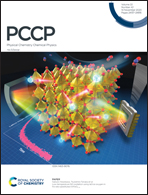Theoretical investigation of protonated thiophene and two of its nitrile substituted derivatives (2-cyanothiophene and 3-cyanothiophene)†
Abstract
Theoretical and experimental spectroscopic data for protonated cyano-thiophenes (R–CNH+ with R = C4H3S), which are needed for their interstellar search and/or detection, are still lacking in the literature. Considering the high abundance and reactivity of H3+ in the interstellar medium (ISM), a quantum chemical investigation on protonated thiophene and two of its nitrile-substituted derivatives (2-cyanothiophene and 3-cyanothiophene) is undertaken for their characterization. The geometrical structures for the title species are calculated at the M06-2X/6-31G(d,p) level of theory, followed by an empirical correction for systematic errors. At the same level of theory, IR and Raman spectra are explored and the rotational parameters are calculated. The proton affinity (PA) of R–CN and the enthalpy, entropy and Gibbs free energy changes (ΔrH, ΔrS and ΔrG) of the reactions producing R–CNH+ are computed at the G2(MP2) and G3B3 levels of theory and at different temperatures. The PA calculations show that the protonation favors the nitrogen atom, while ΔrH, ΔrS, and ΔrG reveal the spontaneous reactions producing R–CNH+ and their neutral forms. In addition, quadrupole hyperfine structures are predicted, while the region where the brightest lines fall at different temperatures is discussed. These results are expected to assist astrophysicists and astrochemists in the search for new species in the ISM.



 Please wait while we load your content...
Please wait while we load your content...